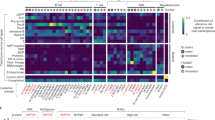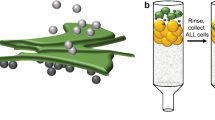Abstract
Infant acute lymphoblastic leukemia (ALL) is frequently characterized by the t(4;11)(q21;q23) cytogenetic abnormality encoding the MLL/AF4 oncogene, increased HOX gene expression and a pro-B/monocytoid phenotype. We have previously established a novel MLL/AF4-positive cell line, B-lineage 3 (BLIN-3), which retains several features of normal B-lineage development (functional Ig gene rearrangement and apoptotic sensitivity to stromal cell withdrawal) not generally observed in infant ALL. We now use microarray analysis to identify patterns of gene expression in BLIN-3 that may modulate MLL/AF4 oncogenesis and contribute to the retention of normal B-lineage developmental characteristics. Comparison of 6815 expressed genes in BLIN-3 with published microarray data on leukemic blasts from t(4;11) patients indicated that BLIN-3 was unique in lacking the expression of certain HOX-A cluster genes. These results were validated by RT-PCR showing no expression of HOX A7 or HOX A9 in BLIN-3. A HOX C8 promoter reporter was active in BLIN-3, indicating that lack of HOX gene expression in BLIN-3 was not due to a nonfunctional MLL/AF4. Our results suggest that B-lineage development can proceed in t(4;11) leukemic blasts in the absence of HOX-A gene expression.
This is a preview of subscription content, access via your institution
Access options
Subscribe to this journal
Receive 12 print issues and online access
$259.00 per year
only $21.58 per issue
Buy this article
- Purchase on Springer Link
- Instant access to full article PDF
Prices may be subject to local taxes which are calculated during checkout



Similar content being viewed by others
References
LeBien TW . Fates of human B-cell precursors. Blood 2000; 96: 9–23.
Wolf ML, Weng WK, Stieglbauer KT, Shah N, LeBien TW . Functional effect of IL-7-enhanced CD19 expression on human B cell precursors. J Immunol 1993; 151: 138–148.
Billips LG, Nunez CA, Bertrand FE, Stankovic AK, Gartland GL, Burrows PD et al. Immunoglobulin recombinase gene activity is modulated reciprocally by interleukin 7 and CD19 in B cell progenitors. J Exp Med 1995; 182: 973–982.
Bertrand FE, Billips LG, Burrows PD, Gartland GL, Kubagawa H, Schroeder Jr HW . Ig D(H) gene segment transcription and rearrangement before surface expression of the pan-B-cell marker CD19 in normal human bone marrow. Blood 1997; 90: 736–744.
Gathings WE, Lawton AR, Cooper MD . Immunofluorescent studies of the development of pre-B cells, B lymphocytes and immunoglobulin isotype diversity in humans. Eur J Immunol 1977; 7: 804–810.
Lassoued K, Nunez CA, Billips L, Kubagawa H, Monteiro RC, LeBien TW et al. Expression of surrogate light chain receptors is restricted to a late stage in pre-B cell differentiation. Cell 1993; 73: 73–86.
Burrows PD, Stephan RP, Wang YH, Lassoued K, Zhang Z, Cooper MD . The transient expression of pre-B cell receptors governs B cell development. Semin Immunol 2002; 14: 343–349.
Wormann B, Anderson JM, Liberty JA, Gajl-Peczalska K, Brunning RD, Silberman TL et al. Establishment of a leukemic cell model for studying human pre B to B cell differentiation. J Immunol 1989; 142: 110–117.
Bertrand FE, Vogtenhuber C, Shah N, LeBien TW . Pro-B cell to pre-B cell development in B-lineage acute lymphoblastic leukemia. Blood 2001; 98: 3398–3405.
Wang YH, Zhang Z, Burrows PD, Kubagawa H, Bridges Jr SL, Findley HW et al. V(D)J recombinatorial repertoire diversification during intraclonal pro-B to B-cell differentiation. Blood 2003; 101: 1030–1037.
Greaves M . Molecular genetics, natural history and the demise of childhood leukaemia. Eur J Cancer 1999; 35: 173–185.
DiMarino JF, Cleary ML . MLL rearrangements in haematological malignancies: lessons from clinical and biological studies. Br J Haematol 1999; 106: 614–626.
Stong RC, Korsmeyer SJ, Parkin JL, Arthur DC, Kersey JH . Human acute leukemia cell line with the t(4;11) chromosomal rearrangement exhibits B lineage and monocytic characteristics. Blood 1985; 65: 21–31.
Yu BD, Hess JL, Horning SE, Brown GA, Korsmeyer SJ . Altered Hox expression and segmental identity in Mll-mutant mice. Nature 1995; 378: 505–508.
Yu BD, Hanson RD, Hess JL, Horning SE, Korsmeyer SJ . MLL, a mammalian trithorax group gene functions as a transcriptional maintenance factor in morphogenesis. Proc Natl Acad Sci USA 1998; 95: 10632–10636.
Milne TA, Briggs SD, Brock HW, Martin ME, Gibbs D, Allis CD et al. MLL targets SET domain methyltransferase activity to Hox gene promoters. Mol Cell 2002; 10: 1107–1117.
So CW, Lin M, Ayton PM, Chen EH, Cleary ML . Dimerization contributes to oncogenic activation of MLL chimeras in actue leukemias. Cancer Cell 2003; 4: 99–110.
Isnard P, Core N, Naquet P, Djabali M . Altered lymphoid development in mice deficient for the mAF4 proto-oncogene. Blood 2000; 96: 705–710.
Dobson CL, Warren AJ, Pannel R, Forster A, Rabbitts TH . Tumorigenesis in mice with a fusion of the leukemia oncogene MLL and the bacterial lacZ gene. EMBO J 2000; 19: 843–851.
Collins EC, Rabbitts TH . The promiscuous MLL gene links chromosomal translocations to cellular differentiation and tumor tropism. Trends Mol Med 2002; 8: 436–442.
Armstrong SA, Staunton JE, Silverman LB, Pieters R, den Boer ML, Minden MD et al. MLL translocations specify a distinct gene expression profile that distinguishes a unique leukemia. Nat Genet 2002; 1: 41–47.
Yeoh EJ, Ross ME, Shurtleff SA, Williams WK, Patel D, Mahfouz R et al. Classification, subtype discovery, and prediction of outcome in pediatric acute lymphoblastic leukemia by gene expression profiling. Cancer Cell 2002; 1: 133–143.
Magli MC, Largman C, Lawrence HJ . Effects of HOX homeobox genes in blood cell differentiation. J Cell Phys 1997; 173: 168–177.
Cillo C, Cantile M, Faiella A, Boncinelli E . Homeobox genes in normal and malignant cells. J Cell Phys 2001; 188: 161–169.
Apiou F, Flagiello D, Cillo C, Malfoy B, Poupon MF, Dutrillaux B . Fine mapping of human HOX gene clusters. Cytogenet Cell Genet 1996; 73: 114–115.
Acampora D, D'sposito M, Faiella A, Pannese M, Migliaccio E, Morelli F et al. The human HOX gene family. Nucleic Acids Res 1989; 17: 10385–10402.
Sauvageau G, Lansdorp PM, Eaves CJ, Hogge DE, Dragowska WH, Reid DS et al. Differential expression of homeobox genes in functionally distinct CD34+ subpopulations of human bone marrow cells. Proc Natl Acad Sci USA 1994; 91: 12223–12227.
Lawrence HJ, Sauvageau G, Ahmadi N, Lopez AR, LeBeau MM, Link M et al. Stage- and lineage-specific expression of the HOXA10 homeobox gene in normal and leukemic hematopoietic cells. Exp Hematol 1995; 23: 1160–1166.
Blatt C, Loten J, Sachs L . Inhibition of specific pathways of myeloid cell differentiation by an activated HOX 2.4 homeobox gene. Cell Growth Differ 1992; 3: 671–676.
Lill MC, Fuller JF, Herzig R, Crooks GM, Gasson JC . The role of the homeobox gene, HOX B7, in human myelomonocytic differentiation. Blood 1995; 85: 692–697.
Lawrence HJ, Helgason CD, Sauvageau G, Fong S, Izon DJ, Humphries RK et al. Mice bearing a targeted interruption of the homeobox gene HOXA9 have defects in myeloid, erythroid, and lymphoid hematopoiesis. Blood 1997; 89: 1922–1930.
Thorsteinsdottir U, Mamo A, Kroon E, Jerome L, Bijl J, Lawrence J et al. Overexpression of the myeloid leukemia-associated Hoxa9 gene in bone marrow cells induces stem cell expansion. Blood 2002; 99: 121–129.
Pocock CF, Malone M, Booth M, Evans M, Morgan G, Greil J et al. BCL-2 expression by leukaemic blasts in a SCID mouse model of biphenotypic leukaemia associated with the t(4;11)(q21;q23) translocation. Br J Haematol 1995; 90: 855–867.
Afonja O, Smith Jr JE, Cheng DM, Goldenberg AS, Amorosi E, Shimamoto T et al. MEIS1 and HOXA7 genes in human acute myeloid leukemia. Leukemia 2000; 24: 849–855.
Drabkin HA, Parsy C, Ferguson K, Guilhot F, Lacotte L, Roy L et al. Quantitative HOX expression in chromosomally defined subsets of acute myelogenous leukemia. Leukemia 2002; 16: 186–195.
Hanson RD, Hess JL, Yu BD, Ernst P, van Lohuizen M, Berns A et al. Mammalian trithorax polycomb-group homologues are antagonistic regulators of homeotic development. Proc Natl Acad Sci USA 1999; 96: 14372–14377.
Kroon E, Krosl J, Thorsteinsdottir U, Baban S, Buchberg AM, Sauvageau G . Hoxa9 transforms primary bone marrow cells through specific collaboration with Meis1a but not Pbx1b. EMBO J 1998; 17: 3714–3725.
Shen W-F, Rozenfeld S, Kwong A, Komuves LG, Lawrence HJ, Largman C . HOXA9 forms triple complexes with PBX2 and MEIS1 in myeloid cells. Mol Cell Biol 1999; 19: 3051–3061.
Thorsteinsdottir U, Kroon E, Jerome L, Blasi F, Sauvageau G . Defining roles for HOX and MEIS1 genes in induction of acute myeloid leukemia. Mol Cell Biol 2001; 21: 224–234.
Calvo KR, Knoepfler PS, Sykes DB, Pasillas MP, Kamps MP . Meis1a suppresses differentiation by G-CSF and promotes proliferation by SCF: potential mechanisms of cooperativity with Hoxa9 in myeloid leukemia. Proc Natl Acad Sci USA 2001; 98: 13120–13125.
Ferrando AA, Armstrong SA, Neuberg DS, Sallan SE, Silverman LB, Korsmeyer SJ et al. Gene expression signatures in MLL-rearranged T-lineage and B-precursor acute leukemias: dominance of HOX dysregulation. Blood 2003; 102: 262–268.
Foucher I, Volovitch M, Frain M, Kim JJ, Souberbielle JC, Gan L et al. Hoxa5 overexpression correlates with IGFBP1 upregulation and postnatal dwarfism: evidence for an interaction between Hoxa5 and Forkhead box transcription factors. Development 2002; 129: 4065–4074.
Kim JJ, Taylor HS, Akbas GE, Foucher I, Trembleau A, Jaffe RC et al. Regulation of insulin-like growth factor binding protein-1 promoter activity by FKHR and HOXA10 in primate endometrial cells. Biol Reprod 2003; 68: 24–30.
Acknowledgements
We thank John Kersey, Paula Croonquist, Michael Linden, Brian Van Ness, Kevin Roberg-Perez (University of Minnesota Cancer Center) and Paul Doran (Affymetrix) for helpful discussions. We also thank Jay Hess (University of Pennsylvania) for kindly providing the Hox C8-Luc vector. This work was supported by National Institutes of Health Grant RO1 CA31685 (TWL) and the Leukemia Research Fund (TWL), University of Minnesota. FEB was supported by the Chris P Tkalcevic Foundation for Leukemia Research as a Special Fellow of the Leukemia and Lymphoma Society. TWL holds the Apogee Enterprises Chair in Cancer Research.
Author information
Authors and Affiliations
Rights and permissions
About this article
Cite this article
Bertrand, F., Spengeman, J., Shah, N. et al. B-cell development in the presence of the MLL/AF4 oncoprotein proceeds in the absence of HOX A7 and HOX A9 expression. Leukemia 17, 2454–2459 (2003). https://doi.org/10.1038/sj.leu.2403178
Received:
Accepted:
Published:
Issue Date:
DOI: https://doi.org/10.1038/sj.leu.2403178



